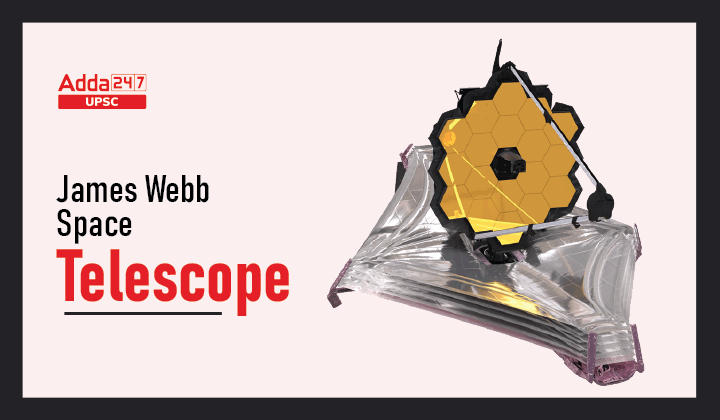Table of Contents
James Webb Space Telescope- Relevance for UPSC Exam
General Studies III- Awareness In The Fields Of It, Space, Computers, Robotics, Nano-Technology, Bio-Technology, Pharma Sector & Health Science.
In News
The James Webb Space Telescope, NASA’s latest and most powerful telescope, has captured new images of our solar system’s largest planet, Jupiter, presenting it in a never-before-seen light.
About James Webb Space Telescope
- WST is a space telescope jointly developed by NASA, the European Space Agency (ESA), and the Canadian Space Agency (CSA).
- It is planned to succeed the Hubble Space Telescope as NASA’s flagship astrophysics mission.
- It will conduct a broad range of investigations across the fields of astronomy and cosmology, including:
- Observing some of the most distant events and objects in the universe such as the formation of the first galaxies.
- Detailed atmospheric characterization of potentially habitable exoplanets
How is it different from other telescopes?
- JWST is more powerful and has the ability to look in the infrared spectrum, which will allow it to peer through much deeper into the universe, and see-through obstructions such as gas clouds.
- As electromagnetic waves travel for long distances, they lose energy, resulting in an increase in their wavelength.
- An ultraviolet wave, for example, can slowly move into the visible light spectrum and the infrared spectrum, and further weaken to microwaves or radio waves, as it loses energy.
- Hubble was designed to look mainly into the ultraviolet and visible regions of the electromagnetic spectrum.
- JWST is primarily an infrared telescope, the first of its kind.
Special features of JWST
- Powerful space telescopes, like JWST or the Hubble Telescope, are often called time machines because of their ability to view very faraway objects.
- The light coming from those objects, stars or galaxies, which is captured by these telescopes, began its journey millions of years earlier.
- Essentially, what these telescopes see are images of these stars or galaxies as they were millions of years ago.
- The more distant the planet or star, the farther back in time are the telescopes able to see.
- JWST will also be positioned much deeper into space, about a million miles from Earth, at a spot known as L2.
- It is one of the five points, known as Lagrange’s points, in any revolving two-body system like Earth and Sun, where the gravitational forces of the two large bodies cancel each other out.
- Objects placed at these positions are relatively stable and require minimal external energy to keep them there. L2 is a position directly behind Earth in the line joining the Sun and the Earth.
- It would be shielded from the Sun by the Earth as it goes around the Sun, in sync with the Earth.
- JWST has one large mirror, with a diameter of 21 feet (the height of a typical two-storey building), that will capture the infra-red light coming in from the deep universe while facing away from the Sun.
- It will be shielded by a five-layer, tennis court-sized, kite-shaped sunscreen that is designed to block the heat from Sun and ensure the extremely cool temperatures that the instruments are built to operate at.
- Temperatures on the sun-facing side can get as high as 110°C, while the other side would be maintained at –200° to –230°C.
- The extremely cold temperatures are needed to detect the extremely faint heat signals from distant galaxies.
- The mirror as well as the sunscreen is so large, they could not have fit into any rocket. They have been built as foldable items and would be unraveled in space.
Important details about Jupiter
- The photographs have captured a new view of the planet, presenting in detail its massive storms, colorful auroras, faint rings and two small moons — Amalthea and Adrastea.
- While most of us are familiar with the yellow and reddish-brown gas giant.
- The JSWT’s Near-Infrared Camera, with its specialized infrared filters, has shown Jupiter encompassed in blue, green, white, yellow and orange hues.
- Jupiter’s famous Great Red Spot, a storm so big that it could swallow Earth, appeared bright white in the image, since it was reflecting a lot of sunlight.
- The brightness here indicates high altitude — so the Great Red Spot has high-altitude hazes, as does the equatorial region.
- The numerous bright white ‘spots’ and ‘streaks’ are likely very high-altitude cloud tops of condensed convective storms.




 TSPSC Group 1 Question Paper 2024, Downl...
TSPSC Group 1 Question Paper 2024, Downl...
 TSPSC Group 1 Answer key 2024 Out, Downl...
TSPSC Group 1 Answer key 2024 Out, Downl...
 UPSC Prelims 2024 Question Paper, Downlo...
UPSC Prelims 2024 Question Paper, Downlo...




